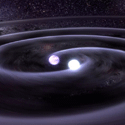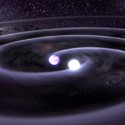Better view of a merging pair
General relativity predicts that massive astrophysical objects in motion emit gravitational waves. There are indirect signs that this prediction is correct, such as the “spin down” in energy of pulsars, but a more direct test is to detect the waves with interferometry. Numerical simulations of the expected gravitational wave signatures for various events are useful guides to these experiments—the challenge is that these computations are tricky and require huge processing power. In a paper in Physical Review Letters, Carlos Lousto and Yosef Zlochower of the Rochester Institute of Technology, US, report their progress in generating gravitational wave forms for pairs of black holes as they orbit each other and merge.
The most promising black hole binaries for gravitational wave detection have mass ratios around , but so far calculations have been limited to ratios around . To break this barrier, Lousto and Zlochower carry out a fully nonlinear calculation with improved numerical techniques and a modified gauge (which is related to how the spacetime coordinates are treated). After hours of computation with processors, they obtain wave forms for the final two orbits of a binary system with mass ratio of before the smaller black hole plunges into the larger one. The ability to calculate signatures for black hole binary mergers for these more extreme mass ratios should enable the large gravitational wave detection collaborations to better understand what they might be seeing. –David Voss





